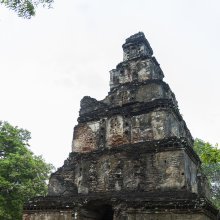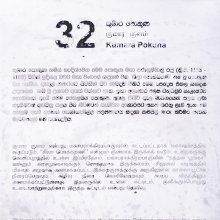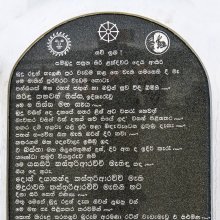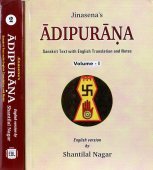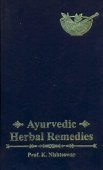Te, Ṭe, Ṭē: 6 definitions
Introduction:
Te means something in Hinduism, Sanskrit, Buddhism, Pali, Marathi, biology, Tamil. If you want to know the exact meaning, history, etymology or English translation of this term then check out the descriptions on this page. Add your comment or reference to a book if you want to contribute to this summary article.
Images (photo gallery)
Biology (plants and animals)
Source: Google Books: CRC World Dictionary (Regional names)Te in Malaysia is the name of a plant defined with Acalypha siamensis in various botanical sources. This page contains potential references in Ayurveda, modern medicine, and other folk traditions or local practices It has the synonym Acalypha siamensis var. denticulata Airy Shaw (among others).
Example references for further research on medicinal uses or toxicity (see latin names for full list):
· Records of the Botanical Survey of India (1922)
· Kew Bulletin (1977)
· Fl. Gen. Indo-Chine (1925)
· Kew Bulletin (1972)
· Bulletin de la Société Botanique de France (1923)
· International Journal of Oncology (2009)
If you are looking for specific details regarding Te, for example diet and recipes, health benefits, extract dosage, chemical composition, pregnancy safety, side effects, have a look at these references.

This sections includes definitions from the five kingdoms of living things: Animals, Plants, Fungi, Protists and Monera. It will include both the official binomial nomenclature (scientific names usually in Latin) as well as regional spellings and variants.
Languages of India and abroad
Pali-English dictionary
Source: Sutta: The Pali Text Society's Pali-English DictionaryTe°, (Sk. trai°) secondary base of numeral three (fr. ti) in compn: having a relation to a triad of, three-; in numerical cpds. also=three (see under tayo).
—kaṭula containing 3 spices (of yāgu), viz. tila, taṇḍula, mugga Vin. I, 210; III, 66; —cīvarika wearing three robes (cp. ticīvara) Vin. I, 253; Ud. 42; Pug. 69; Vism. 60. —daṇḍika carrying the tripod (see tidaṇḍa), Ep. of a brahmin ascetic A. III, 276; J. II, 316 (=kuṇḍikaṃ ṭhapanatthāya tidaṇḍaṃ gahetvā caranto); —dhātuka (nt.) the (worlds of the) threefold composition of elements=tiloka Nett 14, 63 (tedhātuke vimutti= sabbadhi vippamutta), 82; cp. Kvu 605; —piṭaka versed in the three piṭakas (see piṭaka), Ep. of theras & bhikkhus J. IV, 219; Miln. 18 sq.; DhA. I, 7, 384; III, 385; Dāvs. V, 22. Cp. Sk. tripiṭo bhikṣuḥ (AvŚ I. 334 & Index to Divy); —bhātika having 3 brothers DhA. I, 88, 97. —bhūmaka belonging to the 3 stages of being (viz. the kāma, rūpa, arūpa existences; cp. °dhātuka & tiloka) DhA. I, 305; IV, 72; DhsA. 50, 214 (°kusala), 291; —māsa (nt.) 3 months, i.e. a season M. I, 438; Miln. 15; DhA. II, 192; PvA. 20; —vācika pronouncing the threefold formula (of the saraṇa-gata) Vin. I, 18; —vijja (adj.) possessed of the 3 fold knowledge (i.e. either the higher knowledge of the Brahmins, i.e. the 3 Vedas (cp. Sk. trayī vidyā=the knowledge of the Vedas) or of the Buddha & Arahants, as defined at A. I, 164 sq. , viz. (1) remembrance of former births, (2) insight into the (future) destiny of all beings, (3) recognition of the origin of misery & of the way to its removal, i.e. of the Path): 1. brahmanic: D. I, 238; A. I, 163; also as tevijjaka (n.) D. I, 88, 107, 119.—2. buddhistic: Vin. II, 161; M. I, 482; S. I, 194; A. I, 167 =It. 100; Sn. 594=VvA. 10; Pug. 14; DhA. I, 138; Sdhp. 420. —tevijjatā (abstr.) Vism. 5. (Page 306)

Pali is the language of the Tipiṭaka, which is the sacred canon of Theravāda Buddhism and contains much of the Buddha’s speech. Closeley related to Sanskrit, both languages are used interchangeably between religions.
Marathi-English dictionary
Source: DDSA: The Molesworth Marathi and English Dictionarytē (ते).—pron (Poetry.) She. See the popular tī. tē, hē, jē stand, in poetry, for tī, hī, jī.
Source: DDSA: The Aryabhusan school dictionary, Marathi-Englishtē (ते).—pro (Poetry.) She. tēṃ pro It; that.
Marathi is an Indo-European language having over 70 million native speakers people in (predominantly) Maharashtra India. Marathi, like many other Indo-Aryan languages, evolved from early forms of Prakrit, which itself is a subset of Sanskrit, one of the most ancient languages of the world.
Sanskrit dictionary
Source: Cologne Digital Sanskrit Dictionaries: Shabda-Sagara Sanskrit-English DictionaryTe (ते).—ind. With or by thee. E. te substituted for tvayā, but not to be confounded with the optional inflection of the 4th and 6th cases of yuṣmad thou.
Sanskrit, also spelled संस्कृतम् (saṃskṛtam), is an ancient language of India commonly seen as the grandmother of the Indo-European language family (even English!). Closely allied with Prakrit and Pali, Sanskrit is more exhaustive in both grammar and terms and has the most extensive collection of literature in the world, greatly surpassing its sister-languages Greek and Latin.
Kannada-English dictionary
Source: Alar: Kannada-English corpusTe (ತೆ):—[independent] an indeclinable used to express one’s anger, disgust, helplessness, etc.
--- OR ---
Tē (ತೇ):—
1) [verb] to move (a thing) against something else or move (things) over each other with pressure and friction, as to make the former become powder; to rub.
2) [verb] to become worn away, disintegrated.
3) [verb] to cause something to be eroded, erased or deteriorated.
4) [verb] to go back; to retreat; to withdraw oneself.
--- OR ---
Tē (ತೇ):—
1) [noun] the evergreen plant Thea sinensis (= Camellia thea, = C. sinensis) of Theaceae family.
2) [noun] its dried and prepared leaves used to make a beverage; tea.
3) [noun] the beverage made using these leaves.
Kannada is a Dravidian language (as opposed to the Indo-European language family) mainly spoken in the southwestern region of India.
See also (Relevant definitions)
Starts with (+2881): Atum, Boar tooth, Monkey tooth, Te bero, Te Civarik Anga, Te de los jesuitas, Te dzo ba ti, Te macao, Te mai, Te maria luisa, Te re, Te ren, Te uteute, Te Vijja, Te zafan, Te zhinga maka, Te-asiti, Te-cattalisati, Te-civarika, Te-dza-ni.
Ends with (+4828): A-tite, Aane-chogate, Aanesogate, Aba abasanite, Abacate, Abaddhate, Abadhitate, Abadhite, Abauddhikate, Abhadrate, Abhautikate, Abhavatmakate, Abhayadate, Abhedatmate, Abhedyate, Abhidyotayate, Abhijnate, Abhikshamate, Abhilate, Abhimanacyute.
Full-text (+3392): Cad, Plaksh, Bhesh, Civ, Dan, Proth, Klind, Tettannir, Ve, Ranj, Shundh, Mith, Chas, Ciy, Lip, Bhlaksh, Bhlesh, Tir, Riv, Bhresh.
Relevant text
One of your search terms exceeds the minimun character amount per search term. This amount currently equals 2.
No search results for Te, Tē, Ṭe, Ṭē in any book or story.
Related products
